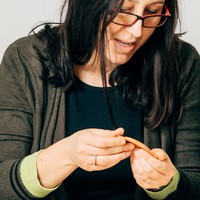Alice Waldner
Austrian Academy of Sciences, Austrian Archaeological Institute, Department Member
- Classical Archaeology, Ancient History, Byzantine Archaeology, Pottery (Archaeology), Ephesos, Miletos, and 30 moreTroesmis, Roman Provincial Archaeology, Ceramics, Hellenistic and Roman Asia Minor, Medieval, Pottery, Black Sea Region Archaeology, Romania, History of Construction, Byzantine, Roman Architecture, Late Antiquity, Byzantine Studies, Roman Archaeology, Survey Research, Late Roman and Early Byzantine Pottery, Roman Pottery, Amphorae (Archaeology), Roman Economy, Roman ceramics, Hellenistic Pottery, Byzantine Pottery, Late Roman Pottery, Cooking and Food Preparation (archaeology), History of Cooking and Food Culture, Wine and Olive Oil Production, Amphorae, Trade, Mediterranean archaeology, and Antic Technologyedit
Research Interests:
Germia was a well-connected Byzantine polis in western-central Anatolia, famous for its healing waters and a church of St Michael. After three years of survey the site can now be reconstructed: it included several other churches and... more
Germia was a well-connected Byzantine polis in western-central Anatolia, famous for its healing waters and a church of St Michael. After three years of survey the site can now be reconstructed: it included several other churches and monasteries, but little space for ordinary residential buildings. This comes as a surprise, but can be explained by the discovery of two older Roman cities within walking-distance of Germia, where the ordinary people seem to have lived. One of these cities, Mantalos, was home to a local cult of the pagan god Men. This may explain why the Christian healing centre was established at Germia. Later, Mantalos shed its pagan legacy and was apparently renamed Eudoxias after a homonymous member of the Theodosian dynasty. No Roman or Byzantine settlement of the region has a history extending back beyond the Iron Age, when the population retreated to fortified hilltop settlements and many sizable Bronze Age höyüks were deserted. Settlement locations changed often and grew little in central Anatolia, and this may be blamed on the uniform landscape of the high plateau; it lacks the Mediterranean's diverse geography of ‘definite places’ that would favour one site above others and ensure its continuity and growth.
Research Interests:
Research Interests:
Research Interests:
Research Interests:
Research Interests:
Urbanitas. Veränderungen von Stadtbild und urbaner Lebenswelt in der Spätantike und frühbyzantinischen Zeit. Assos im Spiegel städtischer Zentren Westkleinasiens. 18.-20. November RGZM Mainz (Organisation Beate Böhlendorf-Arslan)
DER OBERFLÄCHENSURVEY 2012/2013 IN TROESMIS/RO: DIE KERAMIKFUNDE
